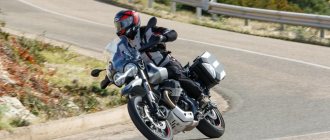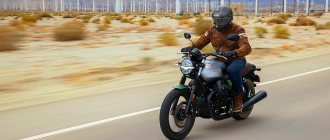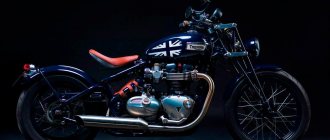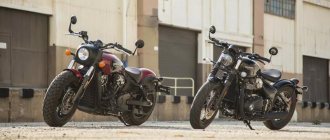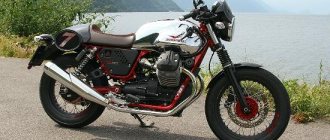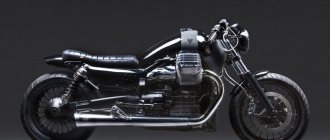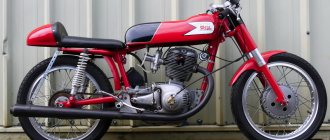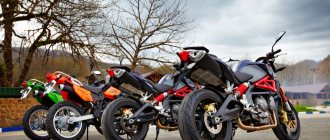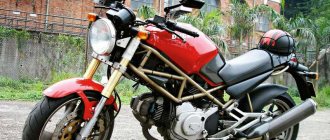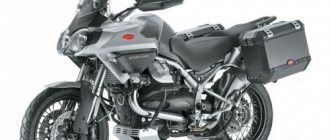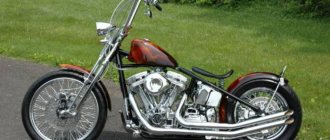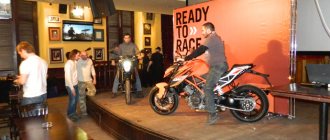City motorcycle Moto Guzzi V9 Bobber Sport 2019
The flat-tracker-inspired bobber gets Ohlins suspension and a sporty riding position.
For a company to exist for almost a century is a serious result, and for Moto Guzzi these 95 years have not been easy. As part of the recent “relaunch” of the brand, the company paid tribute to the traditions of custom building and launched a line based on the V9 platform, which is closer to cruisers, in contrast to road vehicles built on the V7.
First experiments
The first iterations came in the form of the mainstream Roamer custom, while the more sinister Bobber was launched a few years later. A sportier version of the bobber is planned for the 2019 model year, designed to show off the angry racing side of the character. Called the V9 Bobber Sport, the machine was inspired by dirt track racing machines from the 50s.
With the wind in your hair
This phrase is already pretty hackneyed, but some old rocker who is based with Guzzi somewhere in Primorye will understand it well. It's about a (hmm, already extinct?) way of life, freedom on the roads and carefree, and in those days don't print on a flat cider or comparable Chinese copy. The Moto Guzzi Bobber is a machine for analogue motorcycle riders riding alone. If there is power over the rear fender, a seat(s) is added. These riders love the hand-stitched saddle-shaped seats, the wide handlebars that warm the warm summer air in their chests, and the well-placed Boober foot pedals. The unit is nervous and with its 54 “horses” just right, you can again experience that feeling when you twist the gas all the way, still under control. And at the same time, you feel more wind in your increasingly thin hair (under the helmet).
Basic data
Sales: PVG doo
Basic model price: 10.499 €
Design of Moto Guzzi V9 Bobber Sport
The talented developers of the Centro Stile Piaggio Group worked on the design with the participation of the Piaggio Advanced Design Center. Usually this team produces futuristic designs, but for the V9 line they did a great job of stylizing them into the 70s era. The design of the line of devices successfully emphasizes the continuity of generations of Moto Guzzi devices.
Bobber is a dark and masculine image. Black is literally everywhere, including the drag handlebars, mirrors, powertrain and exhaust. For the 2021 model, even the cylinder fins, aluminum tank cap, headlight housing and instrument panel graphics are finished in matte black.
The lowered solo seat complements the new lower handlebars, resulting in a more composed riding position that's compact and sporty, like the rest of the Bobber Sport. The blackened rear shocks of previous versions have given way to cheerful Ohlins with a gas reservoir, contrasting with the new color scheme - orange tank, front fender and side panels. And all this is shaded by two types of black - matte and polished. The short rear fender defines a cropped bobber silhouette, which in the new version is emphasized by a lowered solo seat upholstered in Alcantara faux suede. At the front of the bike, the headlight is lined with a compact black fairing, giving the Bobber a rugged look.
What also makes this Bobber tough are the wheels. Plump donuts 130/90 and 150/80 on 16x discs distinguish it from its civilian relative Roamer. In the 2021 model, the wheels are still alloy, with thin spokes that imitate spoked wheels. Another element of the look is the classic corrugated fork guards, black of course.
>
Good afternoon everyone!
I decided to write a short review of the V9 Bobber model, and in the future I’ll probably post a test drive, because I’m familiar with the motorcycle not from paper, but in person.
To begin with, I’ll write the technical characteristics, although they have probably already been written on this site. But still.
Chassis: ALS steel double tubular frame Wheelbase: 1465 mm Stance angle 26.4° Steering angle: 38° Front suspension: Conventional fork, Ø 40 mm Front wheel travel: 130 mm Rear suspension: Swingarm with double shock absorber with adjustable spring preload . Rear wheel travel: 97 mm Front brakes: stainless steel floating disc, Ø 320 mm, with four-piston Brembo caliper Rear brakes: stainless steel disc, Ø 260 mm, with two-piston floating calliper Wheels: aluminum alloy Front wheel rim: 3.50” x 16” Rear wheel rim: 4.00” x 16” Front tire: 130/90 16” Rear tire: 150/80 V 16” System voltage: 12 V Battery: 12V 18 Ah Length: 2185 mm Width: 840 mm Height: 1160 mm Seat height: 780 mm Curb weight: 199 kg (with all technical fluids, but without fuel) Tank volume 15 l
The motorcycle is already equipped with an ABS system, traction control with two levels and a USB connector on the steering column for charging mobile devices. The instrument panel is designed in the style of a classic round analogue speedometer with an LCD display. The display shows all the necessary information: average speed, travel time, average and instantaneous consumption, odometer and 2 daily mileage counters, gear engaged indicator, clock, display of the activated MGTC (traction) mode. The information displayed on the display is selected using the switch on the left control panel of the motorcycle. Nearby is the MGTC mode selection button.
The motorcycle is made of very high quality and from quality materials. The motorcycle is made almost entirely of metal, even the wings here are actually metal, and not plastic, as is usually done by the Japanese. With all this, the motorcycle is really very light, and on the move it’s like a feather.
Externally, the motorcycle looks very brutal and attracts a lot of attention.
Separately, it is worth paying attention to the power units. Thanks to this engine arrangement, the crankshaft is in line with the driveshaft, and therefore power loss at the wheel is minimal. This is also facilitated by a single-disc dry (not to be confused with a multi-disc dry, as in Ducati, which has a short resource) clutch, like in cars! (feedback on the clutch lever is amazing)
The engine and gearbox are separate here, and not like in most motorcycles, therefore the oil flows into them separately. And the layout is really very close to that of a car. The engine, attached to it is a box with a bell like a car, in which the same clutch is located. This design is perhaps the most reliable of all those used on motorcycles. The gearbox works so smoothly that sometimes you can only understand that you have engaged a gear by looking at the display.
For all Internet theorists, I will immediately say that it does not burn your knees, moreover, you practically do not feel the heat from the engine, and even more so in the area of the fifth point. Nothing bad happens when you fall. There are people who played very hard on other harps. It scratches the cylinder covers and that's it. They are easy to change and not very expensive.
The price for such a motorcycle in Russia from an official dealer is 770,000 rubles.
Well, some photos from the official website
Engine
It is impossible not to notice the 90-degree V-twin with a longitudinal crankshaft, because even in black it is the face of the brand. When the line launched a few years ago, the engine was 90 percent new, and its displacement grew from 744 cc (as in the V7) to 853 cc. cm. Engine power is 55 hp. at 6250 rpm, and torque - 62.4 Nm almost from the very bottom - at 3000 rpm, which is more than enough for the city. A single-plate clutch transfers power to the rear wheel through a 6-speed gearbox via a driveshaft.
Traditional air cooling and 2 valves per cylinder remained in this engine, but an oil cooler was added. The Marelli injector has a single throttle for both cylinders. At idle, like all Moto Guzzi engines, it has a pleasant vibration between the left and right cylinders, and when the revs reach the operating range, the vibration disappears. Two angled matte black mufflers produce a pleasant sound and contain a three-way catalytic converter and two lambda probes.
A bit of classics
Well, of course, Moto Guzzi is a brand that appreciates classic motorcycles and the charm of those golden motorcycling times, so for generations who cannot live without the support of computers and the digital world, this may not be the best choice. Thus, with distinctly classic shapes, 16-inch spoked wheels painted black, muted color options (blue, black, grey) of the fuel tank, a bit of chrome and in black engine and steam, as well as black exhaust pipes , impressed by the classics, the avid motorcyclist or, um, director, for whom Guzzi has social added value in mind. Because, ladies and gentlemen, Guzzi has the status of "Something Different", traditional! And this despite the fact that it even has a miniature digital menu on a classic meter with a white background (no tachometer). Heh, without ABS and rear wheel traction control doesn't work either. Time also moves on in Mandella del Lario. The driveshaft is definitely a must for the Italian and defines the brand.
